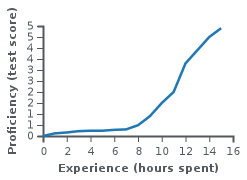DDQ THU 2021-08-26
4. Time to Learn¶
4.1. Agenda¶
General Announcements
Activity
Category |
Assignment |
Day |
Date |
|---|---|---|---|
Term Project |
FRI |
2021-08-27 |
Category |
Assignment |
Day |
Date |
|---|---|---|---|
Paper Presentations |
FRI |
2021-09-03 |
4.2. Activity¶
4.2.1. Introduction¶
Duration: TBD
Shneiderman et al. claim that a successful designer must go beyond the use of vague, subjective measures of, “user friendliness,” “intuitive,” and “natural,” and study evidence-based guidelines in the research literature. This does not mean that subjectivity goes away. On the contrary, it means that subjectivity might be accepted or rejected based on evidence. One of the usability measures that the book argues will lead more directly to practical evaluation is time to learn.
How long does it take for typical members of the user community to learn how to use the actions relevant to a task or set of tasks?
- learning¶
The acquisition of knowledge or skills through experience, study, or by being taught.
- skill¶
The learned ability to perform a task with determined results.
- competence¶
A skill with constraints related to a task’s performance or result (e.g., time, energy, quality, etc.); the ability to perform a task successfully or efficiently.
- proficiency¶
Some measure of competence or skill.
- success rate¶
The percentage of task instances that a user or group of users complete correctly or successfully; often used to indicate proficiency.
- soft skills¶
Any skill skill that does not employ the use of machinery (e.g., social graces, communication abilities, language skills, personal habits, cognitive or emotional empathy, etc.).
- hard skills¶
Any skills that employs the use of machinery, often involving methods, processes, procedures, or techniques, and that must allow for an objective determination of proficiency.

Fig. 4.1 An example of a subject becoming more proficient at a task as they spend more time doing it.¶

Fig. 4.2 An example of a subject who spends a lot of time but does not see an increase in proficiency at first.¶

Fig. 4.3 Tasks that are easy to learn and difficult to learn are often described by short and long learning curves, respectively.¶
When observing a learning curve, a segment that appears steep always indicates rapid learning. This often causes some confusion due to the colloquial use of steep in the phrase “steep learning curve,” because it is often used to express a task that is difficult to learn.
If there is only one steep segment in a learning curve for some task, then its distance from the origin can often help indicate whether the task is easy to learn or hard to learn. As a rule of thumb, the steep segment’s distance from the origin is positively correlated with difficulty; that is, as the steep segment’s distance from the origin increases, so too does the likelihood that the task is difficult to learn.

Fig. 4.4 An example of a subject exhibiting the idealized normal progression of discovery, learning, and reaching their limit.¶
4.2.2. Breakout Groups¶
Duration: \(\sim\) 10 minutes
Important
RANDOMIZE: Please move around to different tables and form a random group for this activity.
Quickly introduce yourselfs to each other, if you don’t already know each other.
Pick a group representative. This person will be responsible for posting your breakout group’s response on Piazza before breakout group work ends for this activity.
Consider a computer-related interface design that a majority of the members of your breakout group have learned how to use, then help your group representative respond to the points below in a followup discussion to Piazza @15. If you’re not sure if your choice of interface is considered “computer-related,” then feel free to ask your instructor.
List the names of your breakout group members.
Include a visual example of the interface (e.g., a screenhot, photo, drawing).
Provide a detailed description of of a single, non-trivial task involving the interface. An example of a trivial task is logging in or logging out of an app.
Note
Consider these questions when describing your task:
What is the goal?
How does the user start the task?
What actions need to be performed?
Are there multiple ways for the user to complete the task?
What factors are involved in successful task completion?
Note
Consider these questions when describing your measure:
Is the outcome always binary?
If there is more than one way to complete the task, are they all treated equally or are some of them preferred?
Is there a time constraint related to successful task completion?
How can you measure or test successful task completion?
Note
Consider these questions when describing your test:
If you were tasked with collecting the information about the factors you described in (d), then how would you set that up?
Is collecting the information about the factors sufficient to determine success? Why or why not?
Do you think your test would still work if repeated (e.g., in a longitudinal study)? Why or why not?
As a group, look at and reply to the posts that other groups made.
4.2.4. After Class¶
Before 11:55PM today, individually comment on another group’s post by replying to their followup discussion in Piazza @15.
Start reading the Foundations module, and make sure you’re aware of current assignments and their due dates.
Comments
Please keep the comments polite and constructive. In addition to whatever else you want to write, please comment on one aspect of a group’s post that you like and one aspect that you think needs improvement (e.g., you find that something is unclear or you don’t understand a justification). As always, be sure to provide a brief justification for each.